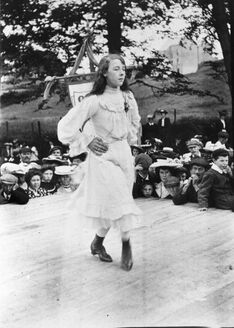 An Irish dancer performing in 1904 in her “Sunday Best” An Irish dancer performing in 1904 in her “Sunday Best” The Look, Part 1: Female Costuming History For many people, all they know of Irish dance is one thing: what a female, competitive soloist looks like. Big, curled hair, lots of makeup, maybe some fake tan on the legs, and, above all: a short, elaborate, bedazzled dress like nothing else in the dance world (or outside of it!) Like anything that’s such a consistent part of our cultural consciousness, we don’t necessarily think to ask the question: why? Why and how did the look we know today for Irish dancers come to be? With Ireland’s tradition of oral history, we don’t know quite how far back the tradition of Irish culture festivals (singular: feis (fesh) or plural: feiseanna) truly goes, but once the records start in the late 19th century, one thing is clear: there were no rhinestones involved. Feiseanna were a celebration of Irish culture, and Irish dancers didn’t have a particular look except that everyone always came in their Sunday best—generally ankle-length dresses, often white, lace-up boots, and with bouncy, curled hair to look their best—sometimes fashioning flowers or crosses made of ribbon to add decoration. However, the dancers eventually wanted their costumes to reflect their culture too! 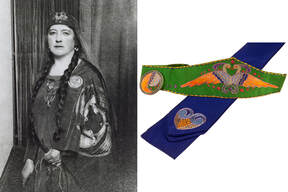 Claire Kennedy, wife of the former Irish Attorney General, in Celtic Revival costume Claire Kennedy, wife of the former Irish Attorney General, in Celtic Revival costume Lasting from about 1885 until the 1930s, the Celtic Revival spread Irish culture not just across Ireland, but internationally, particularly in the production of textiles and ornamental brooches with designs dating back to the 1500s. During this time period, Irish dancers favored handmade, crocheted lace, handcrafted embroidered items in Celtic patterns, as well as pins with elaborate Celtic knots and scrolls that we still see on dancers today (often holding their competitor’s number!) 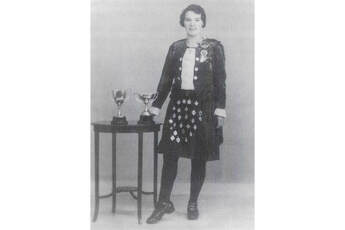 Peggy O’Neil in 1940—note the apron with her many winning medals, which were only worn for photographs Peggy O’Neil in 1940—note the apron with her many winning medals, which were only worn for photographs In the 1930s, with the forming of the CLRG (the main governing body of Irish dance to this day,) we started solidifying the concept of “costuming” within the Irish dance world. 8th century designs began to be favored, with reproductions of early Irish dress a precursor of what’s still Irish dance costume today, including a long tunic with dramatic sleeves (a leine) and a cape (a brat,) as well as handmade lace collars and cuffs. These items were often wrought of handwoven tweed and other handmade fabrics and designs that took inspiration from the famed Book of Kells and ancient, stone Celtic crosses and monuments. Skirts also began to creep up to the knee during this time period to better allow the dancers’ feet to be seen. 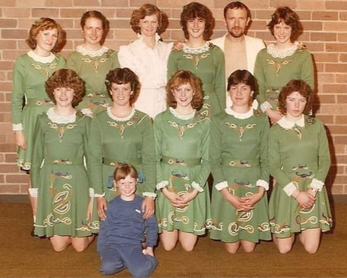 Vintage school costumes via @once_upon_a_feis on Instagram. Note the lace collars and cuffs! Vintage school costumes via @once_upon_a_feis on Instagram. Note the lace collars and cuffs! With the rise of Irish dance schools across Ireland and America (among other countries) in the 1940s, these costumes began to split the difference between historic and modern, transforming into something representative of the school and the Irish tradition behind the art. Touring companies of Irish dancers drew crowds in American cities who were nostalgic for their homes, as the costuming reminded them of historic peasant dress or Celtic artwork. Schools began to dress their dancers in matching school costumes and colors, favoring Kelly green, white, and gold most heavily. Until the modern era, red was considered too English and most schools didn’t utilize it (making SRL’s colors all the more distinctive now!) Tune in next week for a look at the evolution of most important part of any Irish dancer’s look: the shoes! This post is part of a series. Take a look at our last "Origins of Irish Dance" post, all about levels and competitions, here. Also: check out the blog every Monday and Thursday for more posts about Irish history, dance culture, community news, and spotlights on our dancers, staff, and families—among other fun projects! And don’t forget to dance along with us on both Facebook and Instagram.
0 Comments
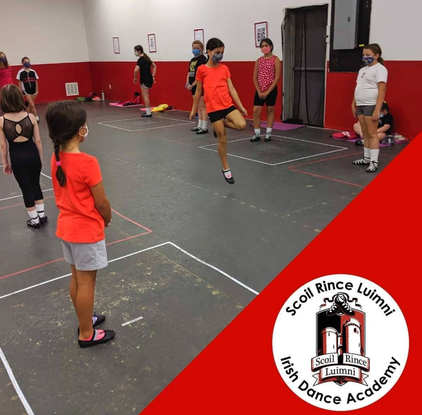 The question Irish dancers get asked the most is: why Irish dance? There’s a lot of amazing things to love about this artistic sport—its long and storied history, cultural enrichment, and beautiful costumes, to name a few—but the benefits of this particular type of dance can be wide-reaching, both physically and mentally, and even life-long! Let’s explore some: Motor Skills & Mind-Body Connection: At the youngest age range—we offer classes starting a 2-years-old!--we concentrate on motor skills and correcting any left/right imbalances early in their development. Starting dance at any age is beneficial, but check out our post about the benefits of starting your dancer early here. Flexibility, Balance, Coordination, and Strength: While many dance studios in the past concentrated more on the steps than the conditioning, SRL has always been committed to providing balanced training that looks at what the whole dancer needs, not just their feet! All age groups are doing more than learning to dance, they’re stretching and completing exercises in class that strengthen the whole dancer. Independence: Whether your dancer is 12 or 2, they’ve been spending A LOT of time with you over the last year. Going into dance class by themselves can be the first step toward forming their own personhood in this time when kids have been isolated at home more than ever. It’s also a fun, safe space for your dancer to make new friends without parental influence! 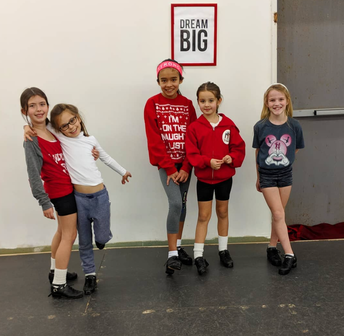 Musicality: Irish dance is unique in many ways, but its connection to music is particularly strong! (Learn more about music in Irish dance here.) Dancers not only develop their sense of rhythm and a deeper understanding of music, but also cultivate an appreciation for traditional Irish music, often choosing to supplement their dancing by learning to play an instrument. Social Skills and Teamwork: Not all of Irish dance is a solo performance! Dance class is a great time for your dancer to practice appropriate social skills, as well as make new friends. Later goals can include céilí dancing and teams, where dancers learn to dance in unison and work together. Goal Setting and Self-Determination: Whether the goal be big (going to Nationals!) or smaller (getting to perform in a fancier dress,) SRL is all about small, every day steps leading to larger goals. We help each dancer set personal goals in their dance career, and this example has proven to carry through in many dancers’ school performance and at home behavior. Irish dance is more about building up skills over time, and is less about instant gratification and more about hard work and dedication—skills that will serve them all their lives! 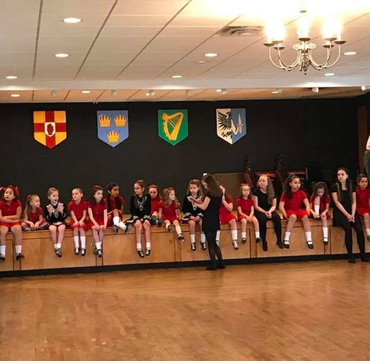 Community: SRL is a community-focused studio where we’re all about supporting each other, even when we’re competing! But Irish dance is more than our studio, it’s a tight-knit, but also global community. All you need to enter that community is a love of Irish dance, and then you’re welcome! Interested in seeing all that Irish dance has to offer? Check out SRL’s Intro to Irish Dance Summer Camp for your dancer! This is a low-commitment way for students 2-12 (and their parents) to gage interest before signing up for classes. Check out the details (and the deals your session will include!) here. We hope to meet you soon! Have any questions? Feel free to call or text our Office Manager, Devon, at 860-385-1107 or shoot her an email at [email protected]. She’s happy to help! This post is part of a series. Take a look at our last 411 post, a longer explanation of our Intro to Irish Dance Summer Camp program, here. Also: check out the blog every Monday and Thursday for more posts about Irish history, dance culture, community news, and spotlights on our dancers, staff, and families—among other fun projects! And don’t forget to dance along with us on both Facebook and Instagram.
Best Dance Memory?
There are so many! Emma had her first solos recall at Oireachtas with SRL so that is big but I think the double feis weekend in Tampa Fl is a best memory, Emma placed first in her Prelim competitions both days allowing her to move to Open Championships and the opportunity to attend her first Nationals that year in Orlando. Any dance parent fails or funniest moments to share? We have had our fair share of crooked wigs, loose headpieces and lopsided "poufs" for SURE. If your dancer is retiring, which parts of being so involved with the Irish dance work will you miss the most? Emma is retiring to focus on school in the fall and I will miss all the one on one time we were able to spend together traveling to feis and competitions. While the dancing was fun and the friendships I've made myself are so very special I will miss that bonding the most. Dance may not be the focus anymore but we will certainly keep the friendships we've made along the way a top priority... they have been our "family" on this journey and mean more than words can say! What's the most important life lesson you think your dancer learned from Irish dance? I think Irish dance has taught Emma perseverance, grace under pressure, humility and the understanding that its ok to not be ok! Do your best work and enjoy the journey. What are your dancers plans for the future so far? Emma will be attending Westfield State University and she will be a Biology Major. Any advice to graduating dancers? To younger dancers and their families? Graduating dancers who will not be dancing anymore enjoy the wig-less weekends and keep in touch with one another... these friendships are special. Younger dancers and families enjoy the journey, remember it’s not a sprint, but a marathon, and these moments go by so quickly. What are your hopes and dreams for your dancer's life? I want Emma to have an amazing college experience, to use the strength and poise she learned in dance to further herself in life, take chances and learn from the ups and downs that life will throw at her. This year has been like no other for sure and these kids have adapted and made the best of very uncertain times and I hope they are all better people for it. This post is part of a series. See our last spotlight with Laura and Emma F. here. Check out the blog every Monday and Thursday for more posts about Irish history, dance culture, community news, and spotlights on our dancers, staff, and families—among other fun projects! And don’t forget to dance along with us on both Facebook and Instagram. Volume VII Kid-Friendly Movies About Ireland, Part 1 So, your littlest dancer isn’t just interested in Irish dance, they’re curious about Ireland—why not use that screen-time to show them something of the culture that created their favorite activity? We’ve collected five, kid-friendly movies that show life in Ireland during varying time periods, with a healthy dose of mythology, family, and fun all mixed in. Take a look: 1. Wolfwalkers (2020, PG) 99% Rotten Tomatoes 8.1 IMDB Watch on Apple TV This movie is a (weekly) recommendation from one of our Beginner dancers, Natalie W.! Natalie loves the beautiful, hand-drawn animation (inspired by the illuminated manuscripts of old Ireland) and storyline centered around two strong, female warriors learning to do what’s right. This is the last of director Tomm Moore’s “Irish Folklore Triology” and is set in 1650 with the (albeit light) political undertones to match. The main story centers on hunter Robyn Goodfellowe, who’s come to Kilkenny with her father (voiced by the legendary Sean Bean) at the behest of the English Oliver Cromwell in order to wipe out a wolf pack in the nearby woods. Robyn’s curious spirit leads her right into the wolves’ trap, but also into their secret world and a new friendship with a wild, forest-dwelling girl named Mebh who may be more than she seems. This is a truly Irish production with an all-Irish voice cast and with music performed by Bruno Coulais and folk group Kíla. This Oscar-nominated film is recommended for ages 8+ due to moderate animated violence and characters facing peril. 3. The Secret of Kells (2009, not rated) 90% Rotten Tomatoes 7.6 IMDB Watch on Prime Video The first of Tomm Moore’s “Irish Folklore Trilogy” centers about the creation of Ireland’s famed (and real!) Book of Kells—an artifact known for beautiful illuminations of both Christian and Celtic mythologies. Young Brendan, a boy living in the remote Abbey of Kells in 9th century Ireland, becomes an apprentice to Brother Aiden, a mysterious illuminator. This decision leads Brendan on a madcap adventure, wrought in beautiful detail, where he needs every ounce of bravery (and some help from his new fairy and wolf friends!) Set in another difficult time for Ireland—this period was full of Viking attacks on the isle as they tried to expand their territories--this film combines the magic of ancient Irish mythology with Ireland’s very real and often troubled past in lush tapestry of animation. This Oscar-nominated (it lost to Up that year) story is recommended for children 9+ due to scenes of mild danger and animated violence. 2. A Shine of Rainbows (2009, PG) 70% Rotten Tomatoes 7.1 IMDB Purchase on Amazon Set in the turbulence of Ireland in the 1960s, this tale follows an orphaned boy, Tomás, as he’s adopted by Marie and Alec O’Donnell and goes to live with them on a quiet isle off the coast of Ireland. Things don’t start out perfect—families never are—but with the help of his new friends, Nancy and Seamus (portrayed by Jack Gleeson—another Game of Thrones alum,) and the unconditional love of Marie, Tomás begins to grow comfortable in his new home. Slight spoiler alert: while this movie was called “a feel-good movie” by Ebert, all paths of inspiring self-discovery and adventure does have deep moments of sadness…but you don’t get the rainbow without the rain. This story centering around found family has a beautiful, whimsical backdrop and is recommended for children 10+, as it is an intensely emotional film. 4. The Secret of Roan Inish (1994, PG) 96% Rotten Tomatoes 7.5 IMDB Watch on Prime Video Set in 1946, the film tells the story of young Fiona, sent to live with her grandparents on the tiny fishing village in Co. Donegal after her parents died during the war. Her grandparents like to tell Fiona all about their ancestral home, a small island off the coast no longer inhabited called Rón Inis, which translates to “Isle of Seals.” Tales of selkies (generally: magical beings who can shed their seal skins to become beautiful woman) abound and Fiona becomes convinced there’s selkie in her ancestry—leading her to head out to the island with her cousin to investigate. We won’t spoil the story for you, but this film has its touches of magic about it, making what could be a sad story one full of love, hope, and family. Recommended for children 8+ due to some heavier topics of loss. 5. Song of the Sea (2014, PG)
99% Rotten Tomatoes 8.1 IMDB Rent on Prime Video We’re rounding out this list with the second of Tom Moore’s trilogy (they don’t need to be watched in order!)—these hand-drawn, animated films are just too beautiful not to! This is another tale drawing inspiration from the folklore of the selkie, but set in 1980s Ireland. Ben lives in a lighthouse off the coast with his mute little sister, Saoirse, and their father, a man still devastated after the disappearance of his wife six years earlier. When their Granny comes to visit, the siblings’ small world is upended and the secrets surrounding Saoirse’s birth are revealed—leading the pair on an adventure to the magical realm of Tír na nÓg to discover the true meaning of love and family. (And some SRL parents have let us know that this may be Moore’s most beautifully done film!) This movie tackles the complications of sibling relationships against the backdrop of magic and folklore versus modernity and is recommended for children 7+. Bonus: something very exciting is coming out May 28th! Watch the trailer for Riverdance: The Animated Adventure or learn more about the film here. This post is part of a series. Read our last post, all about YA book recommendations, here. Check out the blog every Monday and Thursday for more posts about Irish history, dance culture, community news, and spotlights on our dancers, staff, and families—among other fun projects! And don’t forget to dance along with us on both Facebook and Instagram. 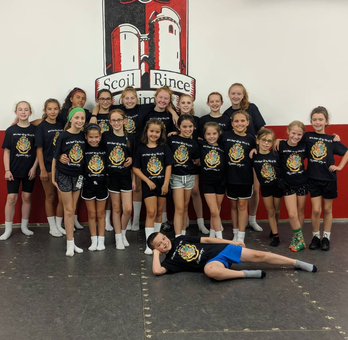 SRL campers in 2019! SRL campers in 2019! Does your child love to jump, wiggle, and move? Have they been bouncing off the walls all year? Are they obsessed with watching dance videos on YouTube when they get their coveted screen time? (Us, too!) Maybe it’s time to find a new outlet for all that excess energy…and why not try Irish dance? With Scoil Rince Luimni’s Intro to Irish Dance Summer Camp program, dancers from ages 2 to 12 will spend a week of classes letting that built up energy out, learning a new skill, and having safe, positive social interactions with new friends! This program is designed to really let your child try out this extremely active and fast-paced artistic sport in a secure and fun environment, but also to let you, as a parent, see if this is the right fit for your family. During one of our two Intro Summer Camp sessions, your dancer will take one class each evening (at a work-friendly time for parents,) for a full week to help them gage their interest (and get in some social time and physical exercise!) 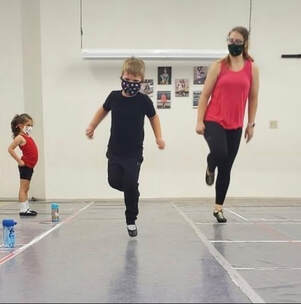 One of our Beginner classes! One of our Beginner classes! As Irish dance has innumerable benefits (like increased coordination, flexibility, balance, and strength…along with musicality and life skills such as goal setting, teamwork, and self-determination,) we’ve added extra value to the Intro to Irish Dance Summer Camp program, as well! While you’ll be able to meet our staff, explore the studio, and get a feel for what Irish dance is all about, your purchase of a session also waives your Fall 2021 registration fee and gifts you the first four weeks of classes come September for free! For our littlest dancers in our Tiny Jig or Pre-Beginner programs (2-5) this is a $155 value for only $82.50, and for our Beginners (6-12) a $216 value for only $132. Sign up and see the full details here: Session 1: July 19-23 or Session 2: August 16-20 Ages 2-3, 5:00-5:25PM Ages 4-5, 5:30-6:00PM Ages 6-12, 6:00-6:45PM Have any questions? Feel free to call or text our Office Manager, Devon, at 860-385-1107 or shoot her an email at [email protected]. She’s happy to help! We look forward to dancing with you soon! This post is part of a series. Take a look at our last 411 post, all about the general benefits of summer camps, here. Also: check out the blog every Monday and Thursday for more posts about Irish history, dance culture, community news, and spotlights on our dancers, staff, and families—among other fun projects! And don’t forget to dance along with us on both Facebook and Instagram. 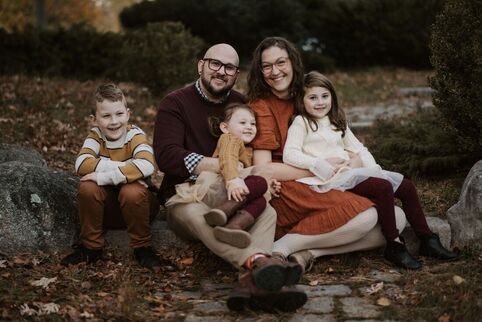 Name: Evelyn Dancer at SRL: Rooney and Tilly (and Me) How did you get started with Irish dance? I grew up in parts of rural VA where there weren’t really Irish dance studios, but I always found the dancers fascinating at festivals. When we moved up to New England I decided to live out my dreams through my children, as one does. When SRL offered another round of adult classes though I figured I might as well give it a try! What benefits do you get out of the adult class? Exercise! Living out childhood dreams. And some social connection in the age of covid. What did you want to be when you grew up when you were little? Why? An archeologist! Ancient Egypt fascinated me and all the stories of the archeologists who explored the pyramids. I actually got to go to Egypt in college. Seeing the Sphinx and the valley of the kings was amazing! 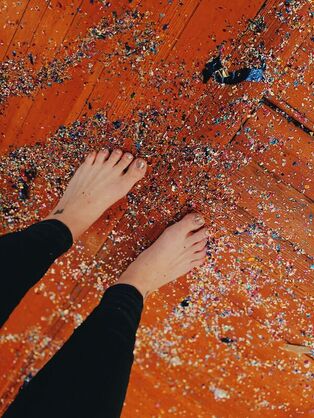 What do most people not know about you? I’m a librarian! I hold three passports. I quilt in my free time. And I really love confetti poppers. If you were a fictional character, which one would you be? Okay, this question made me think of this “scientific” test. I just retook it and got Amy Santiago from Brooklyn 99 as my top hit. And I also rank closely in personality to Twilight Sparkle from My Little Pony and Minerva McGonagall from Harry Potter. All three of which are honestly pretty accurate fictional representations of me. The test is clearly legit. How did Rooney and Tilly get started? I really emphasized the end goal of super sparkly dresses with Rue knowing it would inspire her to try, and luckily I don’t have to feel guilty for that blatant manipulation because she’s loved it so far!! Tilly just wanted to do what her older sister was doing, but also seems to genuinely love it. How did you pick your dancers’ names? We went with a family last name as the first name for my oldest Berreth, and then we just kept with the theme for Rooney and Tilden. How do you think dance has positively affected Rooney and Tilly? Physically it’s helped with coordination and strength. But it’s also helped with focus and determination. And it’s given them a fun way to get their wiggles out and make new friends. Why do you think people dance? It’s like a physical expression of music! Plus there’s so many different ways to dance everyone can do it. What’s the most important quality to have in life? The ability to laugh at yourself. I wish I had learned that earlier in life, not being willing to mess up and laugh it off kept me from trying a lot of things. This post is part of a series. Meet our last spotlighted parent, Michaela J., here. And check out the blog every Monday and Thursday for more posts about Irish history, dance culture, community news, and spotlights on our dancers, staff, and families—among other fun projects! And don’t forget to dance along with us on both Facebook and Instagram. Springtime Old Wives’ Tales We don’t know about you, but we think there’s truly something magical about Ireland. Because of its long-told histories and mythologies, because of its pastoral appearance…and maybe a little bit because the people of Ireland have a tendency to air on the side of caution when it comes it all things faerie and magic (truly—it often disturbs public works projects throughout the country.) And as ancient Ireland-dwellers were agrarian communities whose lives and livelihood depended on the changing of the seasons, it makes sense that springtime was considered an especially magical time of year with plenty of folklore to go along with it. In that spirit of belief and renewal (we could all use renewal after this year!), we’ve gathered together some of Ireland’s springtime old wives’ tales for you to peruse. Now, we’re not saying these are true, but we are saying a place as old as Ireland (inhabited for 10,000 years!) might (maybe…) know what they’re talking about… Note: Every region in Ireland has its own customs, folk tales, and even accents—we’ve noted claimed origins when we were able to! As we mentioned above, the Irish are still loath to disturb “fairy forts” (earthen mounds and ancient ring forts throughout Ireland believed to be entrances to fairy dwellings) and the worst time to disturb them is around Samhain in October or Beltane in May, when the veil between worlds is at its thinnest. Best to leave an offering there instead or you may be facing the wrath of the Aos Sí. In Co. Mayo, people would gather a variety of herbs and flowers to create a mashed poultice they called Bealtanach—this substance was then rubbed on their cows’ udders and believed to increase springtime’s production of butter and milk (and since we don’t have a clear record of what herbs and flowers and many do have medicinal properties, this one could be true!) On May Eve, clean your home’s threshold, sprinkle ashes over it, and wait for the first footprint to disturb the dust. A footprint inward means a marriage in the household this year, but outward supposedly means to expect disaster. (We’re leaving this one alone. Surprised by disaster works just fine.) Many of the May customs involve finding love, including this one from Co. Limerick: sprinkle a plate with flour at sunset and you’ll see your true love’s name. (Other sources say you need a snail as well, to spell it out.) Ever wonder why the springtime favorite, Irish soda bread, has a cross scored into it? Sure, it allows for more even cooking—but it also lets the devil out. (If the devil was steam this would definitely be true.) May flowers (yellow is best, but any and all that are out!) strewn across and around all thresholds (including pasture gates and sometimes even on roofs) help keep away not only the playful faeries known to be closer than ever on Beltane, but also general ill-luck, any evil spirits, and disease. This was prevalent everywhere, but especially Co. Ulster! Lighting your May bush before you head out to the communal bonfire is meant to keep thunder and lightning away. A face washed in fresh dew on the morning of May Day is supposed to be free of sunburn all summer (and some women kept a supply for their beauty routine or its supposed curative properties!)
According to lore it’s bad luck to: dust or sweep during May, get married during May, or to not hear the cuckoo calling during the month. Additionally, on May 1st one should not: sail, dig, whitewash your home, or bathe…all will cause you ill luck for the whole year! And while fire festivals are all generally times of community and togetherness in Ireland, no one would give away butter, milk, or salt on May Day, as it was thought to set the precedent for your prosperity for the year. You don’t want all your food staples for the year walking out the door! The Beltany Stone Circle, located just south of Raphoe in Co. Donegal, is Bronze Age site of 65 standing stones with the unique feature of a cairn at the center (not present in most stone circles on the British Isles.) Beltany’s only decorated stone is aligned with the sun on Beltane, explaining its name and possible ritual purposes. And while there’s a ton of fascinating history and speculation about the site, today we’re interested in the lore: it’s whispered in Raphoe that each of the stones was once a human, punished for dancing on the Sabbath. The one stone a little ways off? The musician who was playing for them, of course! This post is part of a series. Read our last post, all about one of Ireland’s most famous myths, Leprechauns, here. Check out the blog every Monday and Thursday for more posts about Irish history, dance culture, community news, and spotlights on our dancers, staff, and families—among other fun projects! And don’t forget to dance along with us on both Facebook and Instagram 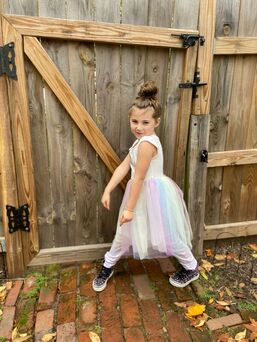 Name: Rooney Age: 5 How long have you been dancing with SRL? Two years What do you want to be when you grow up? A master builder at LEGO who designs LEGO sets. Or a cheerleader. How did you get started with Irish dance? My brother’s friend was dancing at a feis and we went to watch. There were all the girls there in their really fancy sparkly dresses and my mom said if I practiced a lot one day I could wear one too. If you could live anywhere in the world, where would you live and why? Walt Disney World! It’s magical. Or California. 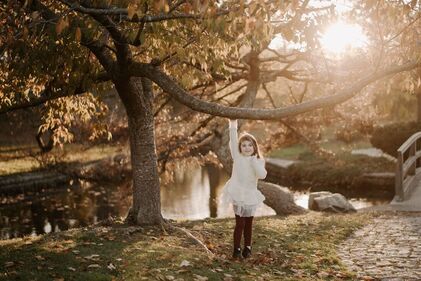 What’s your favorite dance memory? My first year Miss Courtney taught us to do our kicks with a fairy wand! If you opened a restaurant, what would be on the menu? Why? Pasta, corn on the cob, cupcakes, and milkshakes. Everyone likes all of those things. Who do you look up to? My mom and dad! I love them. What’s your favorite thing about dancing? I love all kinds of dance but Irish dance is a fun fast kind of dancing! What’s your favorite thing about your personality? How much I care about other people, especially my siblings. This post is part of a series. Meet our last spotlighted dancer, Rooney's little sister, Tilly, here. Check out the blog every Monday and Thursday for more posts about Irish history, dance culture, community news, and spotlights on our dancers, staff, and families—among other fun projects! And don’t forget to dance along with us on both Facebook and Instagram. Check out our last ten fun facts here. 1. The first, national language of Ireland is, well, Irish (or, in its own language: Gaeilge.) It’s used on all official government documents and you’d be all to see it on public transport, road signs, and all public buildings. (And it’s not “Gaelic”—that’s what they speak in Scotland! “Irish Gaelic” refers to Ireland’s national language.) 2. While Irish government sticks close to its roots, the reality is that only an estimated 2% of people in Ireland speak Irish Gaelic regularly and the majority of Irish people claim English as their first language. Gaeilge is part of the national curriculum…but how much of that high school French do you remember? 3. In the same vein, more people regularly speak Polish in Ireland than Irish Gaelic. Polish people account for the largest non-Irish group within Ireland, making up approximately 2.5% of the population! 4. The ball that drops each year in Times Square on New Years Eve is Irish in origin! (It’s made of famously beautiful and coveted Waterford crystal from, you guessed it, Waterford—a county in the southeast of Ireland.) 5. In Irish Gaelic, there’s no words for yes or no. Well, at least not directly translated. Some common Gaeilge phrases used instead include: tuigim (“I understand”) and níor mhaith liom (“I wouldn’t like.”) More or less, the Irish always need to use more words to get the point across! 6. An Irishman is responsible for answering every kid’s favorite question: “Why is the sky blue?” A scientist named John Tyndall made the discovery in the 1860s (and why the sky turns red at sunset!) (Still curious yourself? This article breaks it down better than we can!) 7. While Americans love to go on and on about the beauty of Central Park in New York City (which is still true—protect our green spaces!), Phoenix Park in Dublin is twice the size! (P.S. It’s not Phoenix like the mythical bird, but the Irish Gaelic fionn uisce or “clear water” is also the size of all the parks in London put together!) 8. Ever wondered why so many Irish surnames include Mac/Mc or O’? Mac just means “son of,” while “O” means “grandson of.” 9. The oldest yacht club in the world is the Royal Cork Yacht Club in Knocknagore, Co. Cork. It’s been in operation since 1720 and sits on second biggest natural harbor in the world (Cork Harbor—only beat by Sydney Harbor in Australia!
10. If you make it to 100-years-old in Ireland, you receive a “Centenarian Bounty”: €2,450 and a letter from the President. Every subsequent year you receive another letter and a commemorative coin! This tradition started in 1940 with Irish President Douglas Hyde. (You do need to apply to receive it, though. Click the above link for an application for your Irish grandparents!) This post is part of a series, read Volume IV here. Check out the blog every Monday and Thursday for more posts about Irish history, dance culture, community news, and spotlights on our dancers, staff, and families—among other fun projects! And don’t forget to dance along with us on both Facebook and Instagram. 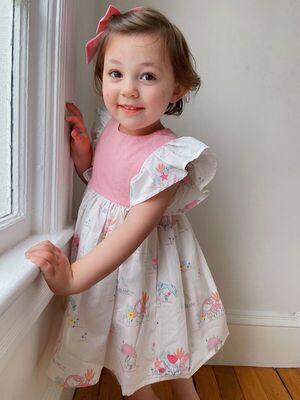 Name: Tilly Age: 3 fingers! How long have you been dancing with SRL? This is my first year. What do you want to be when you grow up? A unicorn princess. How did you get started with Irish dance? My older sister Rooney does it and when SRL started a class for my age group too I got to sign up! What’s your favorite movie? Descendants, Evie is my favorite. 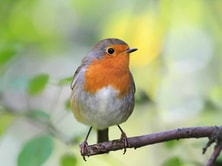 As you may be able to tell, Tilly's family's cats are named Batman and Robin As you may be able to tell, Tilly's family's cats are named Batman and Robin What’s your favorite thing about your Irish dance class? Walking on my tip toes and frog hops! Also my friend Lily. If you were an animal, which one would you be and why? A piggie! Because I like pigs. How do you make someone happy? Give them a cat. Cats make everyone happy. What would you tell a new dancer? I like Irish dance and you will too!! This post is part of a series. Meet our last spotlighted dancer, Colby, here. And check out the blog every Monday and Thursday for more posts about Irish history, dance culture, community news, and spotlights on our dancers, staff, and families—among other fun projects! And don’t forget to dance along with us on both Facebook and Instagram. Springtime Traditions, Part 4 Beltane Happy May Day! (Well, two days late.) As Americans, we’ve all heard about May Day celebrations, but chances are all the words conjure for you are a vague image of girls dancing around a pole with ribbons. Or maybe the words just alarm you (though, fun fact: mayday as a distress call is actually just a corruption of the French m’aider which means, unsurprisingly: help me.) However, if you’re not new to the blog, you won’t be surprised to hear that in Ireland, May 1st has a long history of celebration—all the way back to its druidic, pagan past. Beltane (pronounced bel-tein) is one of the four major fire festivals in Gaelic, pagan culture and has been observed from April 30th into May 1st for as long as there have been people in Ireland. The name means “bright fire” or, alternatively, “fires of bel” for the Celtic sun god, Belenus, as this bright twin of Samhain (which marks the beginning of winter) was meant to mark the beginning of summer on the Emerald Isle. Though there’s plenty of healthy debate about Belenus’s exact role in ancient, Irish worship, most sources see him as a Gaelic equivalent to Apollo, especially as he’s often depicted with similar accouterment: a chariot being driven across the sky, a corona of light, and the sun. However, Belenus had additional associations that fit a springtime god well: healing and medicine (to this day, shrines to Belenus often include therapeutic and sacred springs,) fertility and sexuality, and even livestock and crops. Like all the major fire festivals (check out our posts about Samhain and Imbolc—and we’ll see you this summer for Lúnasa) in Gaelic culture, Beltane was a time when the community came together at a shared bonfire to honor Belenus and relight their own hearths from the blaze—but Beltane is notable for its tradition of having two bonfires. As the ancient Irish were a largely agrarian people who were early cultivators of livestock, these bonfires did more than bring everyone together, but were believed to honor the return of the sun and thus, a return of life after a long, hard, hungry winter. People would drive their cattle between the two bonfires to let the smoke wash over the animals to bless them, protect them from disease, and encourage fertility, before driving them out to pasture for the warmer months. The sacred smoke was also thought to bless those in attendance and sometimes, the brave would leap over the fires in an attempt to garner even better luck. Much like Samhain, Beltane was also believed to be a time where our world and the Otherworld (in Gaelic: Tír na nÓg aka the faerie world,) were closest. Also much like Samhain or Yule, decorations were placed in and around the home to ward off trickster faeries (who might be looking to steal milk and butter from the livestock they just went to such careful trouble to protect—people left the faeries their own milk and honey outside instead!) But what does one decorate with in May? Why, May flowers, of course! Yellow flowers such as buttercups, primroses, and marigolds were especially coveted, and people supplemented their floral decorations with greenery—in some regions whole boughs or bushes that were additionally decorated with strips of colorful cloth! These decorations were a multifaceted part of the day: they were celebratory of the warmth and sun in the months to come, but also thought of as protection—everyone knows the fey love beauty can’t resist stopping to smell a pretty flower! Like all other pagan spring celebrations, Beltane was also holiday focused on fertility and new life. Not only were homes decorated with flowers and greenery, in some regions flower crowns or posies were popular accessories for unmarried or newly married women (and even placed on the cattle people were hoping to breed and protect.) While the iconic Maypole was a later, English addition to the festivities (and were most popular in heavily English-influenced areas,) it gained popularity over time and became a part of the communal festivities in many areas. The dance around the Maypole has long been considered by historians to be a remanent of a fertility ritual, and many towns would then crown a May Queen from the dancers to lead a procession—a tradition thought to be Roman in origin, originally in worship of the spring goddess, Flora.
While most of us probably didn’t have access to a Maypole (or any cattle to bless) this year, we can certainly get behind celebrating spring after this long, (isolated) winter! While these types of agrarian celebrations seem a truly ancient part of our past some days, humans will always be excited to see the sun after the coldest months of the year. So, as you go about your modern life this early May, maybe pick some daffodils and leave some milk and honey out for the faeries—you know, just in case. This post is part of a series. Read about the tradition of Mothering Sunday in our last installment here. Check out the blog every Monday and Thursday for more posts about Irish history, dance culture, community news, and spotlights on our dancers, staff, and families—among other fun projects! And don’t forget to dance along with us on both Facebook and Instagram. |
SRL NewsFind all of our latest news on our Scoil Rince Luimni Facebook page! Categories
All
Archives
August 2022
|
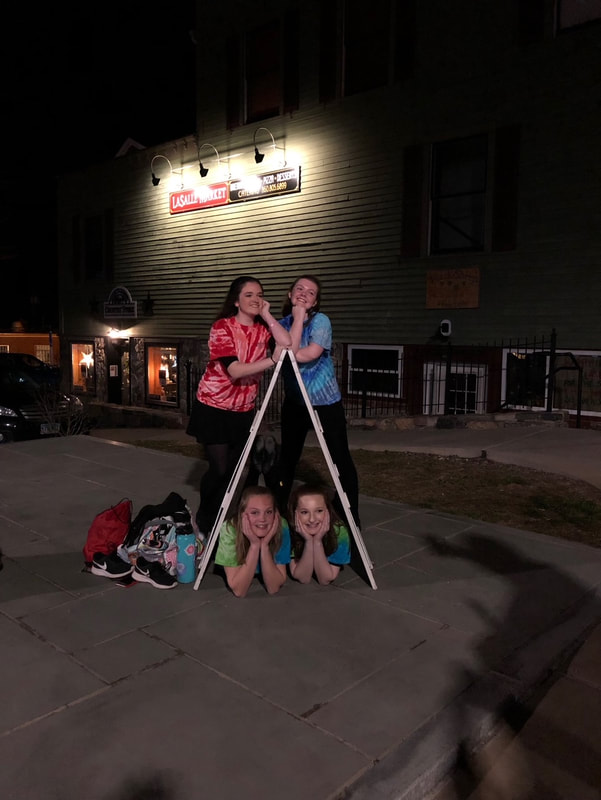
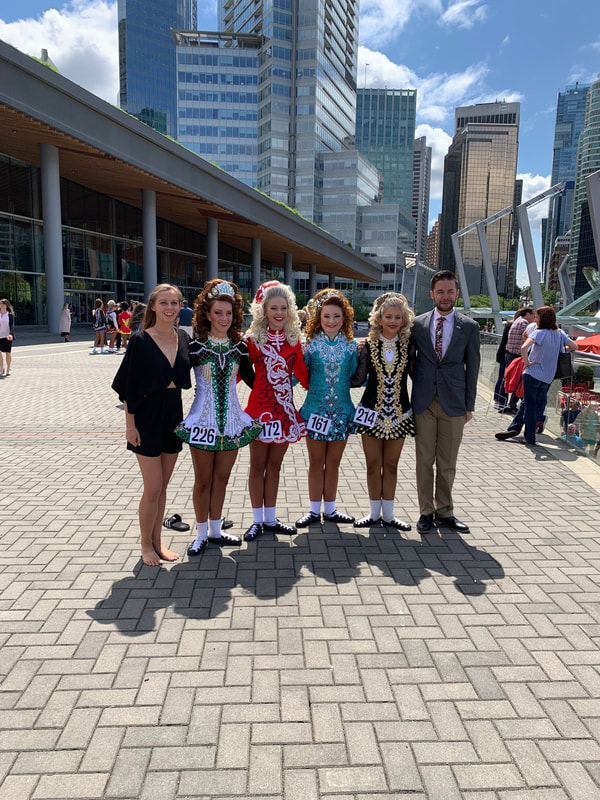
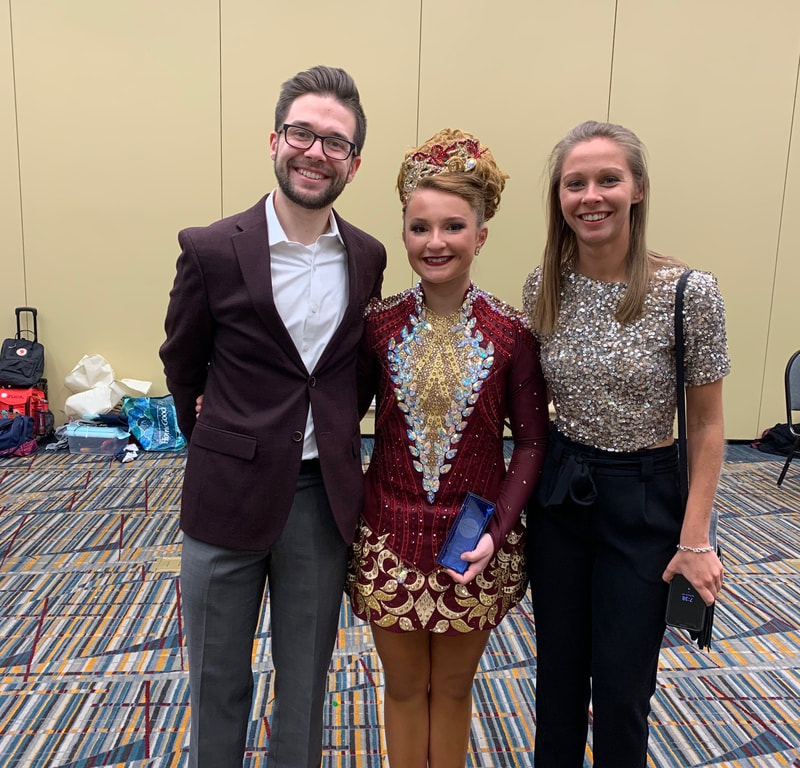
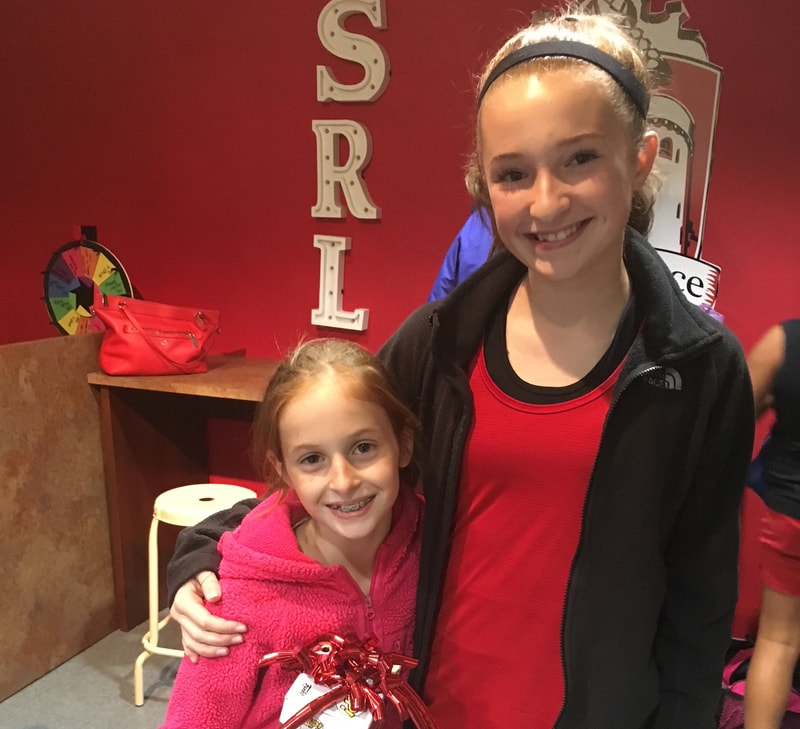
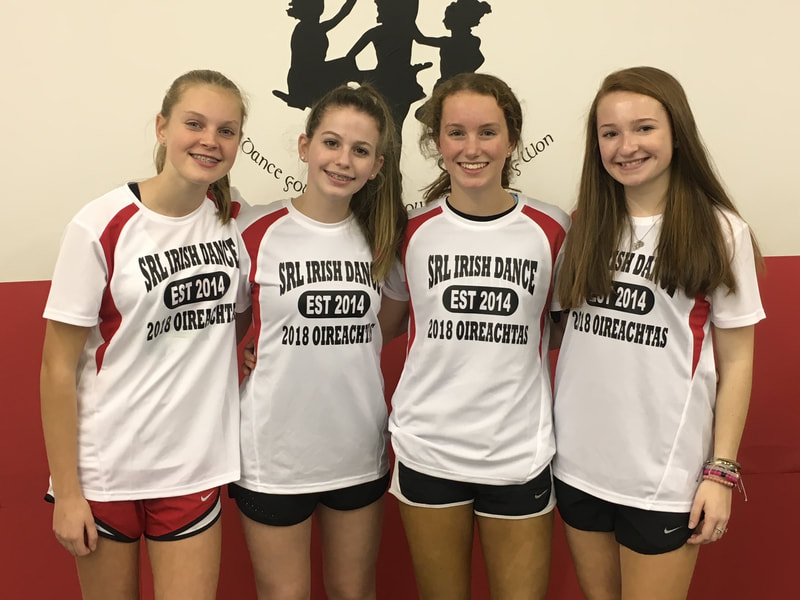
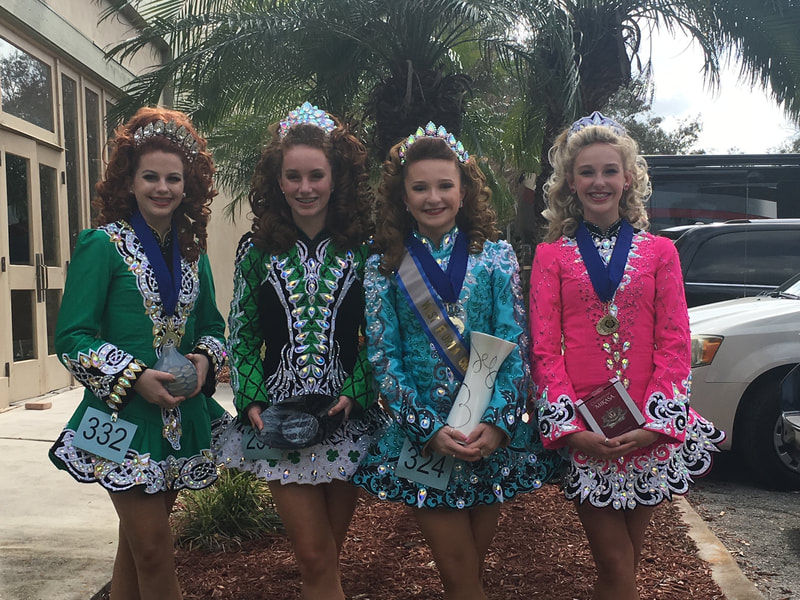
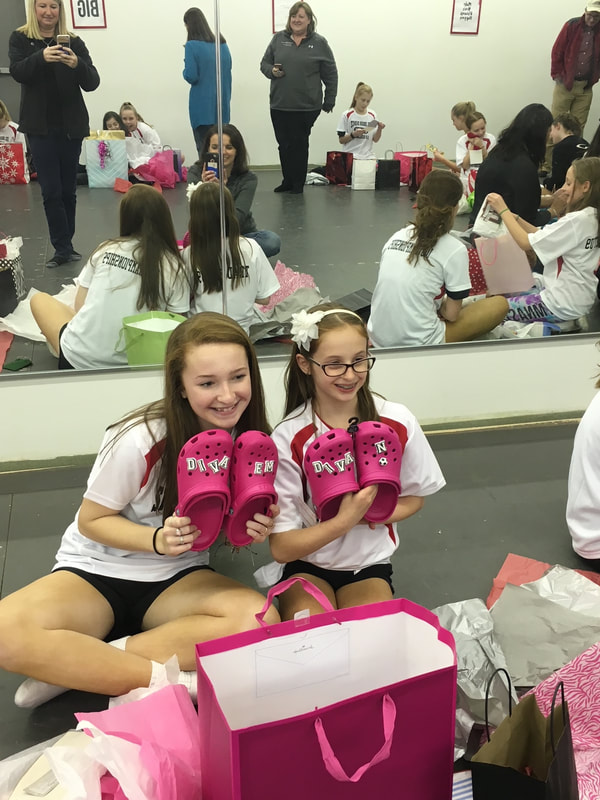
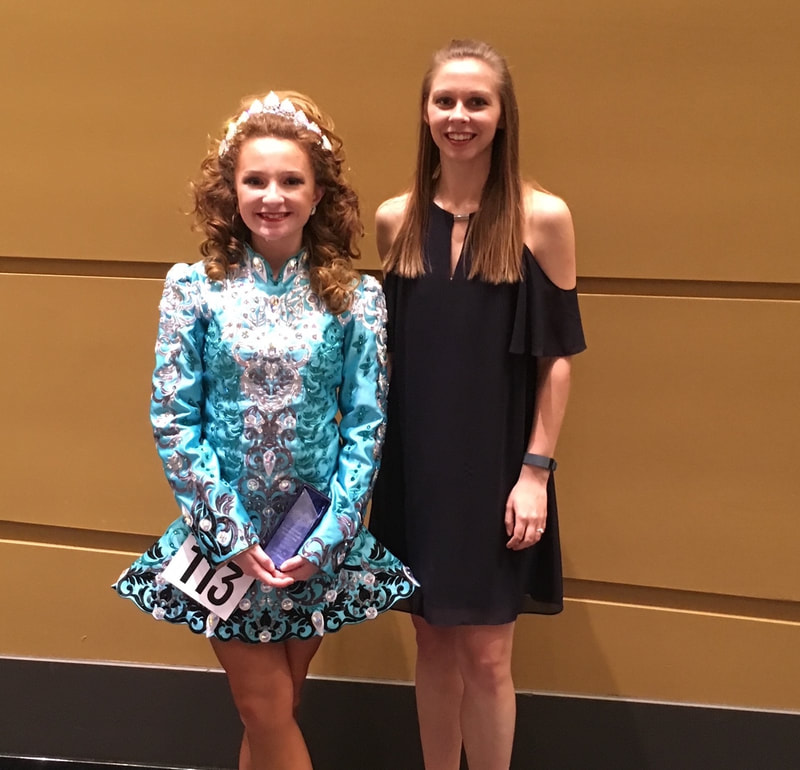
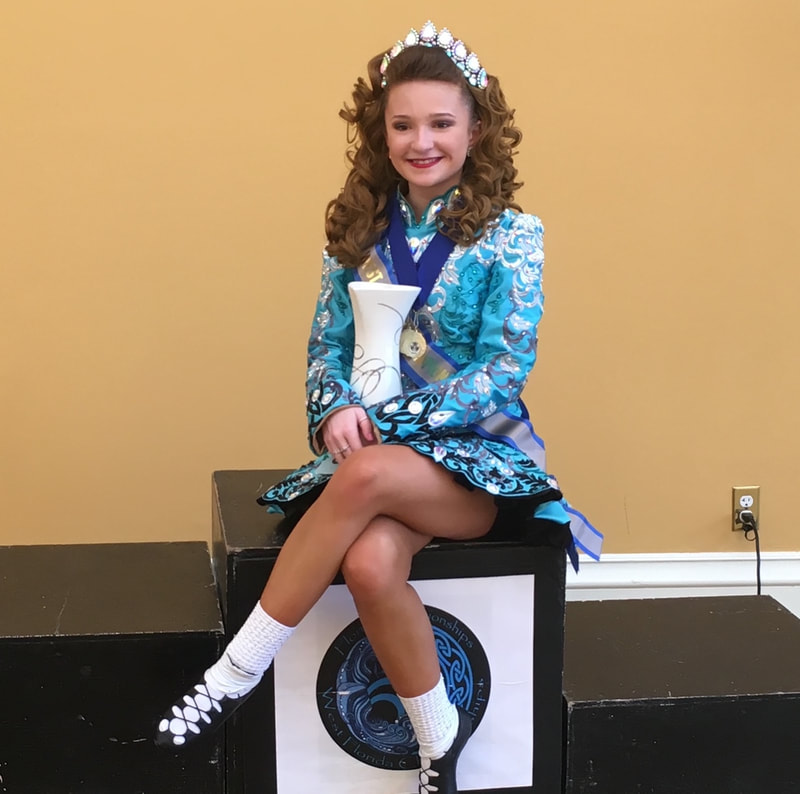
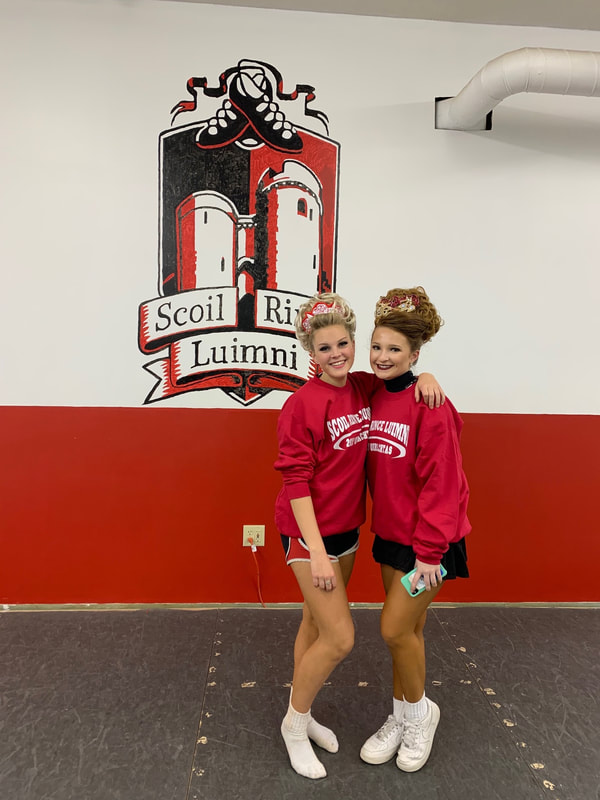
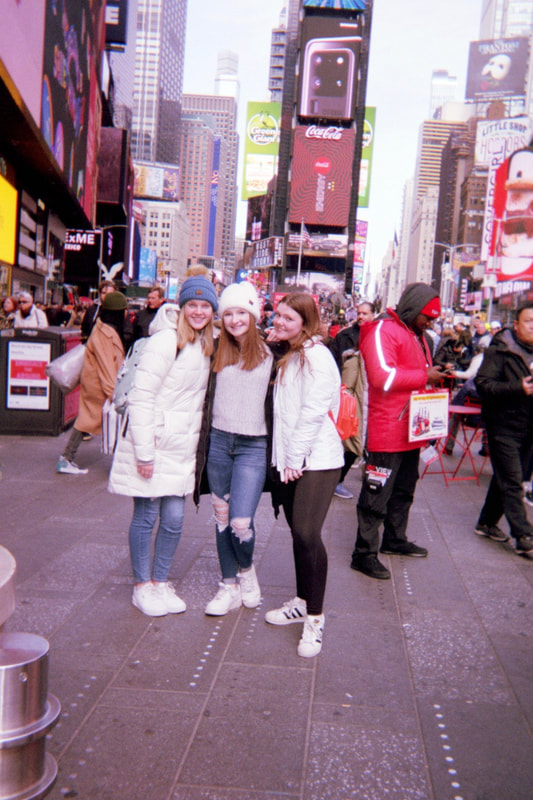
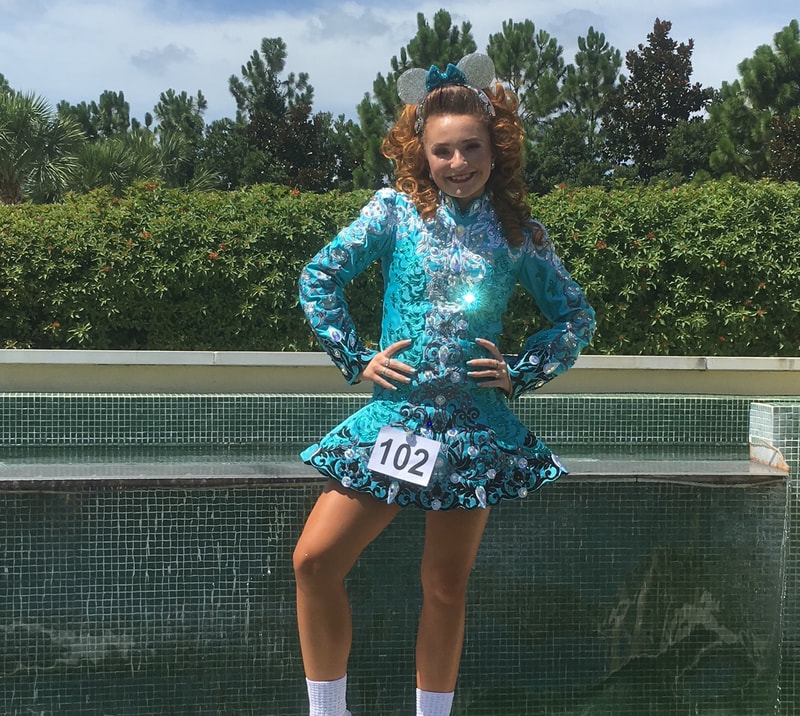
 RSS Feed
RSS Feed